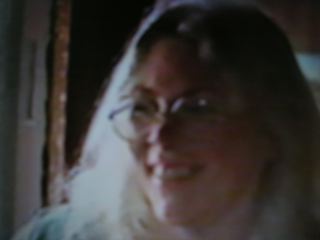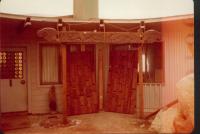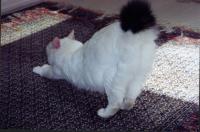County Supervisor’s District’s are divided up on this 1930s map (click to enlarge): 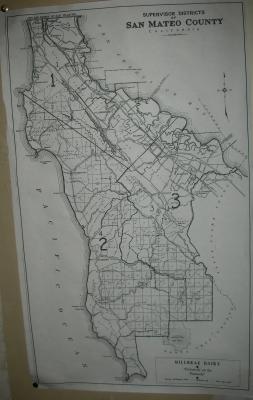
Coastside Cheesecake
Once Upon A Time
Looking out on El Granada beach, circa 1930s, as painted by the locally famous artist Galen Wolf
The two-story building was an Ocean Shore-era “bathhouse” and, to the south, there’s what looks like a farmer’s barn. For years Galen lived at Frenchman’s Creek and every corner of the beautiful Coastside was his canvas.
Kirlian Photography
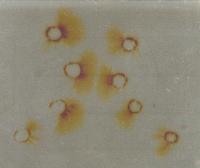 This was the energy field, “the aura” around my fingers a quarter century ago. The aura was captured via Kirlian photography –which allegedly reveals the unique body’s spirit energy at the moment “the picture” is taken.
This was the energy field, “the aura” around my fingers a quarter century ago. The aura was captured via Kirlian photography –which allegedly reveals the unique body’s spirit energy at the moment “the picture” is taken.
Earthy photographer Michael Powers of Miramar –and of kyak and geodesic dome and and spiritual fame took the “picture ” using special Kirlian photography equipment 25 years ago.
When I first arrived on the Coastside, Michael Powers was a successful greeting card photographer. He often featured the natural beauty of Half Moon Bay in his trademark picture.
Here’s one Michael took of his former wife, Maria and their daughter, Marika, feeling merry in the lovely local flower fields.
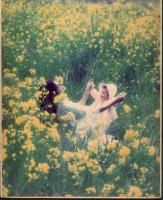
Remembering Woodworking Craftsman Chuck Bodin
When I first got to the Coastside it wasn’t like it is today–it wasn’t bustling, there wasn’t construction going on everywhere, the roads were carless, especially Highway 92 (wheeeeee) and the hot waves hadn’t been discovered by the young men & women in their wetsuits.
Happy days. Woodworker Chuck Bodin plays on El Granada beach. 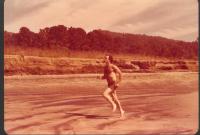
Not much had happened to HMB since after WWII in the 1950s, and for me that was the Coastside’s charming appeal. Very few people lived on the ong and narrow marine terrace, bounded to the east by the coastal hills and mountains. The fickle fog that covered everything up on the Coastside could be seen from afar by people standing in the bright warm sun on the other side of the hill–better to stay home, they said, looking over the at the ocean.
Sure, there were farmers and folks lucky enough to have llived on the Coastside all their lives–but what I found was a bohemian atmosphere– and that’s what appealed to me. There was a small, close-knit community of carpenters and woodworkers. So if something terrible happened to a member of this community or among the fishermen the news spread fast.
MaryLou, Chuck’s wife, hams it up for the camera.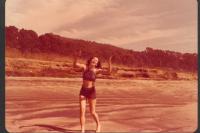
On or about March 24, 1975, Chuck Bodin, at 39, an older member of the craftsmen community, was killed in a car crash on Highway 92. He owned a big old truck, one of the biggest I’d seen around here but he need it for the projects he worked on and for wood he was moving around. Chuck also owned a red VW bug and that’ s what he was driving somewhere near the “House of Doors” on the day he was killed heading “over the hill”.
The minute the sad news broke, the El Granada community–where Chuck, his wife, MaryLou and daughter resided–rallied around the family. At the time Mary Day (Schlecht) was the “mother” figure and a dinner was announced at her home–an old white Victorian-style home built on an oversized lot.
Mary was in charge of everything–the town meetings were held there, birthdays, you name it. She was heavily involved with the “Voice of the Coast” newspaper and a dependable, active member of the tiny community.
The night we lost Chuck his friends and neighbors came together. His brother, Rudy, came, and I recall he played a significant role in Ken Kesey’s brilliant “One Flew Over the Cuckoo’s Nest”, either the play or the movie, perhaps as a director. The local dentist Fred and his wife, Cathy were there and other prominent carpenters like Michael Sharpe.
One of Chuck Bodin’s last projects was the construction of a pair of gorgeous doors for a beautiful Moss Beach home overlooking the Pacific Ocean. I’m going to share a photo of those with you.
I might add that Pete Douglas (Bach Dancing & Dynamite Society) often generously turned his place over to locals for memorials and other celebrations of life and death.
These magnificent doors leaning up against this unique Moss Beach house represent one of Chuck Bodin’s last projects–
Panama Hat?
Coastside Cat
Who’s The Boss?
Crack In The Edge of The World
I’m halfway through Simon Winchester’s new book, “A Crack In The Edge of The World: America and the Great California Earthquake of 1906”.
Since we live with the SAF (San Andreas Fault) this is good reading:
Winchester has written an enjoyable synthesis of California history, northern California history–but having much earlier read John McPhee’s “Assembling California”, I find echoes of that great author’s work.
I’m not a geologist and I don’t pretend to understand all of what I’m reading.
Although I’m not done with Winchester’s book, I’ve become aware of one of the main points. Since 1906 most experts believed the quake’s epicenter (the point where the quake started) was in the town of Olema in northern California. That’s because there was so much visible movement of fences and roads there. The Olemans are proud to be at the epicenter–but it turns out the truth is Olema is not the epicenter. Mussel Rock in Daly City is! Well, Mussel Rock is very much within driving distance of El Granada. You can reach it by driving through Pacifica and it’s a beautiful, jagged cliffy beach (forget about the dump that’s nearby) where people hangglide.
Unlike Olema, which is really not the epicenter but the proud pretender, Daly City is the epicenter but Daly City doesn’t want anyone to know.
Experts say Mussel Rock, and not Olema, was the epicenter of the 1906 quake but locals don’t want the blame or fame.
If you look at earthquake maps, the land west of the famous San Andreas Fault is on what is called the Pacific Plate–this is the “coast” of California where there sure isn’t a lot of land there compared to what’s on the other side, the east side of the San Andreas Fault which is located on what is called the North American Plate. And the rest of the US is sits on the North American Plate. Are you with me?
In El Granada we are living on the Pacific Plate.
That’s just part of the story. The San Andreas Fault has three parts–briefly, the northern and southern parts are locked in to the North American Plate but there is a 125 mile stretch in the center (at Parkview, California) that is not “locked in” and is always nervously fidgeting, caushing, if you think about it, immense stresses on the northern and southern parts. Pushing and pulling to free itself from the north and south. That’s the way I understand it.
Did I get it right?

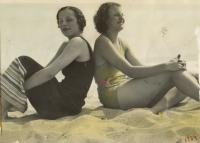
 Galen Wolf, Coastside artist.
Galen Wolf, Coastside artist.